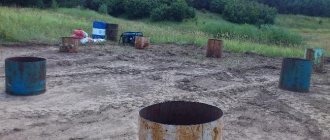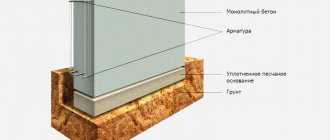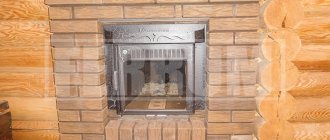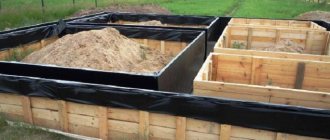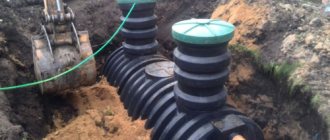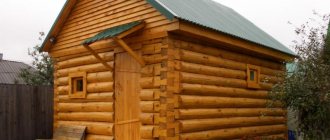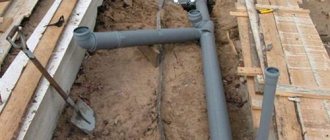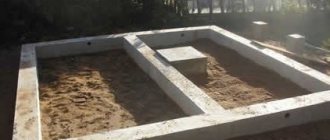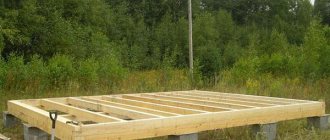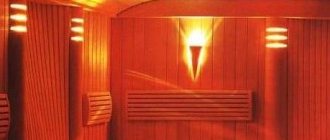The solidity of the building itself depends on the foundation, so the choice and construction of the foundation should be taken with full responsibility. Today, more and more land owners prefer foundations on tires. This is an inexpensive, prefabricated option and a creative way to build a DIY sauna base. Can be used in any climatic conditions.
Design features of a rubber foundation
Car tires are a relatively new type of building foundation. It was created at the end of the last century, combining the parameters of sustainability and efficiency. This type of foundation is also called Semykin, as it was created by St. Petersburg resident Mikhail Semykin. Most often, tires from trucks, as well as agricultural and special equipment, such as tractors or large snow removal units, are used to build a bathhouse. They have a large diameter, so the weight of the bath is distributed more evenly. But you can take passenger vehicle tires, you’ll just need a large quantity of them.
Tire rubber has valuable properties such as water resistance, vibration absorption, elasticity, and weather resistance. It resists abrasion and repeated stretching and bending well, and the process of its decomposition takes more than 100 years. There are other advantages of tires.
- The cheapest and most durable permanent formwork with external reinforcement.
- There is no need to build and dismantle formwork.
- The ratio of height to diameter is at least 1:3, resulting in resistance to uneven settlement and freezing.
- The ability to combine into blocks in the vertical and horizontal direction using any fastenings (including curled wire), strengthen the reinforcement, and install various embedded elements.
- Various variations of filling with material to transfer load to the ground.
- Low labor costs in repairing, replacing and strengthening tires, especially when using columnar non-buried foundations, allowing you to correct errors in calculations and foundation construction technology.
- The simplicity of tying the support tires with a grillage made of reinforced concrete, steel, timber, logs, or completely abandoning it and assigning its functions to the load-bearing elements of the bathhouse.
- Easy to combine with any other types of foundations.
These qualities make it possible to create a solid foundation for the bathhouse. When increased pressure occurs on individual sections of the rubber supports, the walls of the tire begin to move apart, albeit slightly, but sufficiently to reduce the transmitted impact on the grillage or lower trim of the bathhouse.
On such a foundation you can build a bathhouse even on peat soils.
From the everyday life of a tire mechanic
In order to better understand whether there is a rational grain in such a decision or whether this is just another near-construction nonsense, you need to turn to the tire itself. Every year, hundreds and thousands of tire shops around the world are faced with the problem of recycling waste and scrap tires.
The requirements for the quality and condition of wheel tires in civilized countries are very strict, the tires themselves are very large and occupy a significant amount of space, and their scope of use is quite limited. The French manufacturer of premium automobile tires, Michelin, known for the quality of its tire casings, has launched the Remix truck tire restoration program, restoring the working layer on the old carcass in the factory.
Scrupulous and practical Germans have been recycling recycled rubber for several decades, adding crumb rubber to the asphalt concrete mixture when laying their famous highways, the Japanese living in an area of high seismic activity began to use waste tires when constructing the foundations of buildings and structures, trying to use their useful quality as resistance to deformations. The Japanese are famous inventors and innovators, so it’s worth taking a closer look at this option.
Pros and cons of foundations made from car tires
Taking into account the properties of such a material, we obtain a stable base that will withstand significant loads. From tires you can build several foundation varieties for baths: columnar, strip and solid (tile).
A foundation made of rubber elements has a number of advantages.
- Possibility of use in areas with high seismic resistance, as well as in areas with permafrost.
- The elements are not afraid of seasonal ground movements, as they are able to absorb any uneven deformations, so they can be used in heaving soil.
- Can withstand significant loads from the weight of the bath itself.
- Low volume of earthworks.
- Simplicity of design.
- It has excellent waterproofing properties: it does not absorb moisture from the soil, which prevents the bottom lining of the bathhouse from getting wet.
- Durable.
- Quick and easy to construct. One person is enough for the work. There is no need for heavy construction equipment.
- Much cheaper than other types of bases.
In addition, a tire foundation is a good way to dispose of the huge number of car wheels in landfills, which are harmful to the environment.
The disadvantages of rubber foundations made from tires are their destruction and the release of harmful substances when exposed to direct sunlight. To prevent this from happening, it is enough to cover the rubber with protective materials.
If you don’t like the look of the tire foundation, you can do external finishing so that the overall appearance of the bathhouse does not suffer. Disadvantages also include the need to construct only frame structures of the building and the impossibility of using a tire base in hilly areas.
Application area
Having decided to build a foundation on tires with your own hands, decide on the mass of the structure, weigh the pros and cons, and carefully study the possibility of using automobile ramps as the basis for a future building. Be sure to consult with professional builders. The operation of buildings erected by private developers confirms the possibility of using used tires for the installation of the following buildings:
- one-story country houses, the walls of which are made of wooden beams;
- small frame-type structures characterized by reduced weight;
There are several options for laying a foundation from already used car tires.
- utility and domestic buildings (sheds, cabins, toilets) erected on summer cottages;
- small premises intended for use as a bathhouse.
The construction of a permanent building on a base made of car tires can lead to unforeseen results and cause additional financial costs. Excessive arrogance of the developer, lack of construction knowledge, and the desire to save money on the construction of the building’s foundation can lead to fatal consequences. It is better to use a tire foundation as a basis for small buildings that are light in weight.
Preparation for construction
Foundation design is an important aspect of the preliminary construction stage. In the process of its implementation, it is necessary to create a detailed drawing of the future bathhouse, taking into account the structural features and indicating the dimensions. The project can be done either independently or using computer programs.
The selection and acquisition of materials is the second point of work. To build a rubber foundation, old decommissioned tires are used. They must be intact, without breaks. Tire wear doesn't matter. Their size is selected individually, depending on preferences and availability - from tires for cars and trucks to agricultural and special equipment such as tractors or large snowblowers.
The larger the diameter of the tires, the better their durability. It is necessary to choose tires of the same diameter and thickness, as this will greatly simplify the work. You also need to take care in advance of delivering the required amount of this material to the construction site.
Next, measurements and calculations are performed. Let's say you decide to build a continuous covering. First you need to calculate the required number of tires for the construction of a rubber foundation. For clarity, let’s calculate using an example, for which we take average statistical data. The original dimensions of the bathhouse base: 4 m long and 3 m wide. The outer diameter of the tire is the sum of the seat diameter (indicated in inches) and the height, which is indicated in the marking.
Let's say the mark on a tire 205/60/R15 indicates a tire width of 205 mm, a tire height of 60% of the width, and a seat diameter of 15 inches. The outer diameter will be the sum of the seat diameter (15 inches = 38.1 cm, since 1 inch is equal to 2.54 cm) and the tire height (205 mm x 60% = 123 mm), multiplied by two. That is, for a tire marked 205/60/R15, the outer diameter is 38.1 cm + (2 x 12.3 cm) = 62.7 cm or 0.627 m.
Having decided on the initial data, we perform the calculation. Let's say with these numbers.
| Algorithm | Examples |
| Divide the length of the base of the bath by the tire diameter | 4 m: 0.627 m = 6.38 pcs. |
| We also divide the width of the bathhouse base by the tire diameter. | 3 m: 0.627 m = 4.78 pcs. |
| The resulting data is multiplied and then rounded up. | 6.38 x 4.78 = 30 pcs. |
Thus, to build a rubber foundation, in our case we will need 30 tires. They can be laid in one layer, then the height of the base will be equal to the width of the tire, or in 2-3 layers. As a result, the foundation will be 41 cm–61.5 cm high, since the width of the tire, based on the markings, is 205 mm or 20.5 cm.
To create a tire base, you will need the following materials and tools.
- tires;
- shovels;
- boards or pipes for tamping;
- fragments of bricks, gravel;
- sand;
- roofing felt or linoleum;
- formwork boards for constructing a solid foundation made of tires;
- fittings;
- building level.
Before constructing a tire foundation, preliminary work is carried out to prepare the construction site: the area is cleared of stones and debris, and the top layer of earth 30 cm thick is removed.
Only a wooden structure should rest on a foundation made of tires, since wood has elasticity and is not afraid of small vibrations. In brick buildings, cracks form due to their sensitivity to even the slightest shifts. Therefore, it is not recommended to build a block or brick bathhouse on it.
Feedback from experts on the practicality and features of bus foundation technology
Semykin's foundation on tires is constantly subject to confrontation of polar opinions for and against from authoritative experts in construction. Proponents of the technology primarily note the positive dynamics of organizing thermal insulation for a home without the injection of additional consumables, as well as the versatility of application for almost all types of soil. Tires can be used to create a sufficient area for support, avoiding expensive technologies. It is the flaws of particular examples that receive criticism rather than the patented technology as a whole. For example, a bathhouse on a foundation made of tires with proper ventilation will, on the contrary, be better ventilated and last longer than on a traditional concrete foundation.
To insure the base from premature destruction, it must be sheathed with protective materials (siding, wood, asbestos cement slabs, decorative PVC panels.
Sometimes reviews from construction company specialists about the harmfulness of using rubber pop up on forums. If the recommendations are followed, tires do not emit any foreign odors that penetrate the room.
Why, according to the advice of experts, you should not overdo it in waterproofing. Careful waterproofing without ventilation vents can lead to a greenhouse effect indoors and mold. Log houses made of timber and wooden cottages are at risk.
The statistical majority of opinions of authoritative experts and those who have actually implemented the construction of foundations from tires boil down to the fact that frame structures can stand without deformation or subsidence for at least 20 years.
Construction of a rubber foundation from tires
In order for the base made of tires to serve for a long time and at the same time reliably hold the bathhouse, it is necessary to correctly perform all the work on its installation, as well as provide reliable protection from exposure to sunlight. The main criterion when creating a foundation from car tires is control of their positions in the same plane and at the same level. Errors here can lead to distortion of the entire foundation.
The construction of a slab foundation consists of several stages.
- They dig a pit 20 cm deep according to the dimensions of the future bathhouse, retreating 20 cm along the perimeter. This measure is necessary so that when concreting the outer edges of the tires are also covered. This will not only strengthen the base, but also prevent the release of harmful substances under the influence of sunlight. The depth of the hole does not depend on the thickness of the tires.
- Checking the water level, level the bottom of the pit, constantly compacting it.
- The tires are laid flat on a flat surface, close to each other. Inside each of them we lay roofing material, which will prevent the stuffing from spilling out and serve as additional waterproofing.
- The space inside the tires is filled with earth, sand, gravel or construction waste, compacted with a pipe or board with a handle. Similar actions are carried out between the tires, filling the gaps. The denser the material is compacted, the better and more reliable the foundation of the bathhouse will be. Do not fill the rubber on top: the filling should be located at the same level as the top side of the tire.
- To ensure that the concrete pour is uniform, roofing material or linoleum is spread on the prepared surface. One layer of such coating is sufficient if the strips are laid with an overlap of at least 5 cm.
- Around the laid tires, formwork is installed from waste boards or plywood 10–15 cm high.
- Reinforcement is placed on roofing felt in the internal space of the formwork and tied together with steel wire or welding is used. To secure the structures of the walls and partitions of the future bathhouse, anchors are attached to the reinforcement frame and placed above the concrete level.
- Fill with plastic concrete to the height of the formwork, which will serve as the upper part of the tire base. It is important to ensure that it is horizontal using a building level. Deviations from the concreting plane should not exceed 10 mm per 1 meter.
- Next, a lower frame of the bathhouse made of timber or metal channels is erected on it, which is attached to the anchors.
To speed up the hardening of concrete, use old rags soaked in ammonia.
They are laid on the pouring surface and covered with polyethylene. This measure helps to extract moisture from the concrete, which helps to achieve the required strength within a week. Some land owners do not fill tires with concrete, but buy a ready-made reinforced concrete slab. But such a foundation will cost much more than one made by yourself.
A foundation made from tire posts is also reliable, although it has less load-bearing capacity. It differs from a tiled base in that the free-standing tire columns inside are filled with concrete. First, markings are made around the perimeter of the future bathhouse using pegs. Tires are placed on the pegs, and anchors are inserted inside them. Each tire is filled with stones, broken bricks or gravel and poured with concrete. Don't forget to place pieces of linoleum or roofing felt under the tires. The tires should be at the same level in the corners of the bathhouse and intermediate nodes.
Conclusion
In the video presented in this article you will find additional information on this topic. Also, based on the text presented above, we can conclude that a foundation created on the basis of tires is quite simple to make. At the same time, taking into account the availability and price of this material, the finished structure will be inexpensive and at the same time very practical (see also the article “Strip foundation for a bathhouse: from excavation to pouring concrete”).
Did you like the article? Subscribe to our Yandex.Zen channel
Strip foundation on rubber tires
It is erected on soils that have low bearing capacity or a large freezing depth, which is facilitated by the sufficient width of the tires, providing a significant area for load distribution. The construction is similar to the technology of constructing a solid base, but differs in some nuances. The position of the axes of the load-bearing walls and partitions of the bathhouse is determined on the ground and secured with pegs located no closer than a meter from the axis. This is very important because the load must be transferred in the middle.
A trench is dug along the intended axes, the width of which is 10–20 centimeters greater than the width of the tire, and the depth is necessarily less than the depth of soil freezing. At least two rows of tires are placed in the trench and filled with bulk material. Metal rods are inserted inside the tires as anchors for tying to the bottom of the bathhouse. The installation of the strip base is completed by pouring concrete.
After constructing a foundation for a bathhouse from tires, the protrusions that formed when laying the foundation under the structure can be easily decorated with any building material, which will give the structure an aesthetic appearance. A foundation made from old, used tires does not require special care. If it is positioned correctly and protected from the sun at the initial stage, then during subsequent use it will not cause any trouble.
A foundation made of tires is the optimal and economical option for building a base for a bathhouse. And how to lay it, everyone decides for themselves. The main thing is good knowledge, the necessary construction supplies and a great desire.
Where else are tires used?
Tires are a functional component that can be used not only for its intended purpose. To arrange the base, tires are laid in two ways:
- as a “container” into which concrete is poured;
- they can serve as supports located in the corners of a small building, for example, if a chicken coop, barn or gazebo for family gatherings is being built.
You should not treat construction negligently - a certain list of recommendations and requirements of the technological process will still have to be followed.

